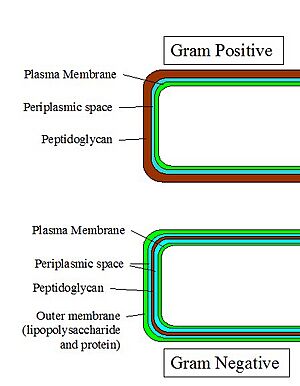Gram-positive facts for kids

Gram-positive bacteria are tiny living things that are stained a dark blue or violet color when a special test called Gram staining is used. This is different from gram-negative bacteria. Gram-negative bacteria do not hold onto the crystal violet stain.
Instead, gram-negative bacteria pick up a different color, like red or pink, from another stain. The main reason for these color differences is how their cell walls are built.
Contents
What Makes Them Special?
Gram-positive bacteria have a very thick layer in their cell wall. This layer is made of something called peptidoglycan. Think of it like a strong, protective shield around the bacteria.
Because this peptidoglycan layer is so thick, it helps protect the bacteria. It means they do not need other rigid cell walls for support. This thick layer is also why they hold onto the purple stain during the Gram test.
How Gram Staining Works
Gram staining is a common test used by scientists to tell different types of bacteria apart. It helps them identify bacteria quickly. This test uses several steps and different colored dyes.
First, a purple dye called crystal violet is added to the bacteria. Gram-positive bacteria soak up this purple dye. Next, a special solution is added that helps the purple dye stick even better inside the bacteria.
Then, alcohol is used to wash the bacteria. Gram-positive bacteria keep their purple color because their thick cell wall traps the dye. But gram-negative bacteria lose the purple color at this stage.
Finally, a red or pink dye, like safranin, is added. Since gram-positive bacteria are already purple, they do not change color. Gram-negative bacteria, which lost their purple color, now turn red or pink.
Gram-Positive vs. Gram-Negative
The biggest difference between gram-positive and gram-negative bacteria is their cell wall. Gram-positive bacteria have that thick peptidoglycan layer. This layer is on the outside of their cell membrane.
Gram-negative bacteria, on the other hand, have a very thin peptidoglycan layer. It is not as strong or thick. Because their peptidoglycan layer is so thin, they need an extra outer membrane for protection.
This outer membrane in gram-negative bacteria also makes them harder to treat with some medicines. Knowing if a bacteria is gram-positive or gram-negative helps doctors choose the right antibiotics.
Related topics
Images for kids
-
Violet-stained gram-positive cocci and pink-stained gram-negative bacilli
See also
 In Spanish: Bacteria grampositiva para niños
In Spanish: Bacteria grampositiva para niños





